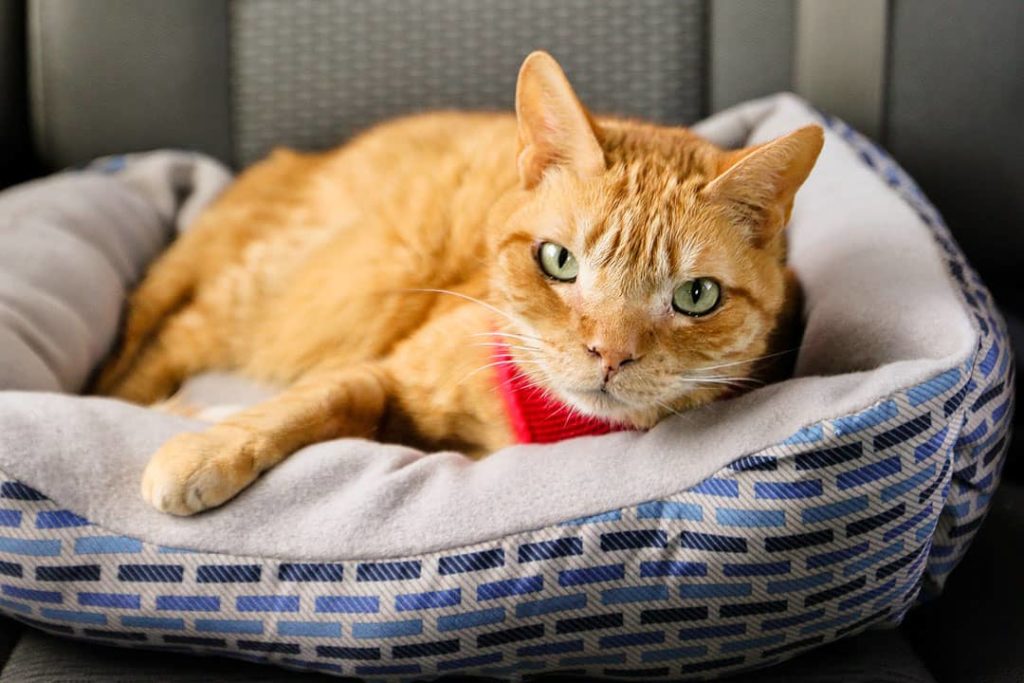Cats travel tricks? Is your cat under any medication? If yes, then you will definitely need to pack it for the trip. You will also need a lot of other essentials such as food, water, feeding trays and a litter box. Speaking of, when on a plane it is usually hard to find an opportunity to slip your cat out of the carrier to pee. You can, therefore, put a pee pad in the corner of the carrier to make it easier for your cat, especially on long flights. While at it, don’t forget to pack a litter scoop, waste bags and cleaning wipes to take care of your cat’s waste while in transit. If your cat is used to regular grooming, pack grooming equipment as well. Lastly, things like your cat’s blanket, a soft carrier lining, and some toys will help relax your cat when on the road. Buying a cat backpack is a great way to transport your cat and make sure you have the important items you need.
Cat sedatives are basically the same as human sedatives. They are used to keep your cat calm and docile on an airplane, in a car, or in any other possibly traumatic situation. Most contain the same active ingredients that are found in sedatives for humans, just like benzodiazepines. In fact, benzodiazepines are the most common cat sedative and considered the best and safest. The others are diphenhydramine, chlorpheniramine, gabapentin, clonidine, and SARI – but today we will talk only about benzos. Benzodiazepine can be used to sedate your cat and is an effective muscle relaxant and anti-anxiety medication. A small dosage of Benzodiazepine will make your cat relaxed and a little bit sleepy. Basically, your cat gets stoned. Have some people argue that this is better than using sleeping pills, as it does not actually knock your cat out or do any harmful damage. The only major side effects of using this sedative are nausea, vomiting, and respiratory depression – the same as in humans.
My name is Lucas and I have 2 ragdoll cats. First, there is Grandma Cat (GC) and she is 24 years old. Second is Maya and she turns 14 this year. Both are Seal point (well maybe mitted) Ragdolls, and as you might expect have their fair share of personality. I quite like cats and this site is all about living and travelling with ragdoll cats. Hope you enjoy the site and feel free to contact me. If you are searching for pet travel articles you can see extra information at https://myragdollcats.com/cat-sedative-for-travelling-in-car/.
A hard sided carrier is going to provide you with the most support for transporting your cat. They will also be more durable and easy to clean. It’s important to note that if you are flying with an airline approved hard carrier, they may not fit under your seat very well, but if something should fall onto the case, your cat will be safe. Hard sided carriers will have a steel wire or steel mesh door that is going to be much more durable than plastic and any hardware on the case should be metal. The handle for your carrier should be stout enough for you to comfortably carry your cat, but it should also be strong enough to support the weight of the carrier and the cat. Most cat ?rucksacks also come in both a soft and hard option so make sure that you consider them as part of your buying decision.
Wikihow recommends feeding your cat its main meal upon arrival at your destination. The cat may get carsick if you overfeed him during the course of the trip. It’s not a good idea to feed him the morning of or during your trip. Offer water at rest stops to keep the cat hydrated. You can also feed him in small portions or offer treats, but only when the car is parked. Prepare the litter box every time the cat feeds. If it’s a really long trip, you can stop every couple of hours to relax and walk around with your cat. This would be much easier if the kitty is leash trained. If your cat isn’t trained to walk on a leash, never take the cat out of his carrier during rest stops. Most importantly, never leave him alone in the car. Discover additional information at https://myragdollcats.com/.
